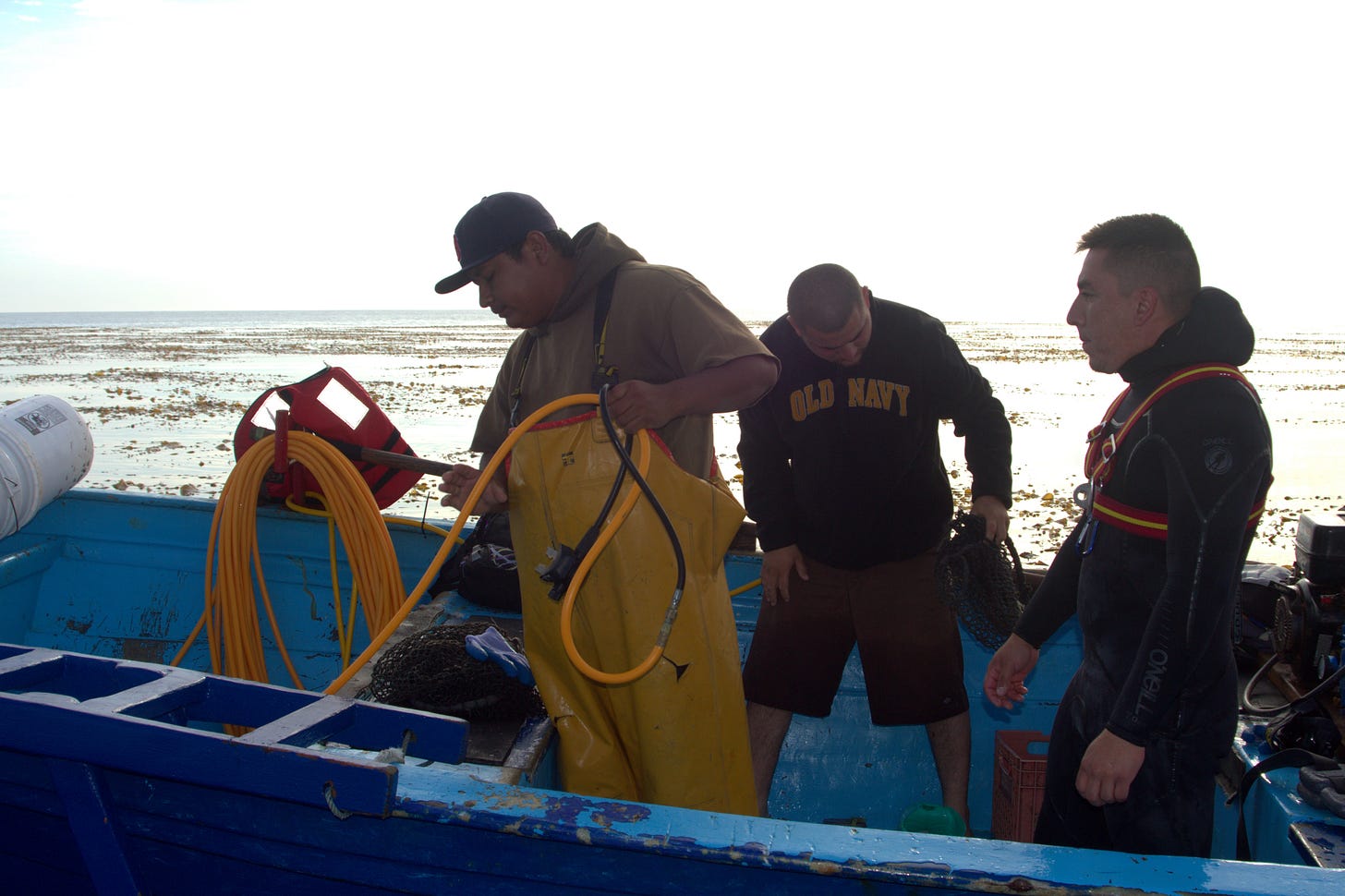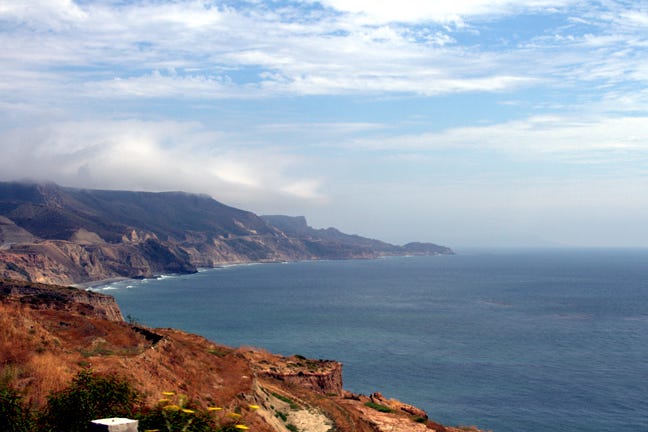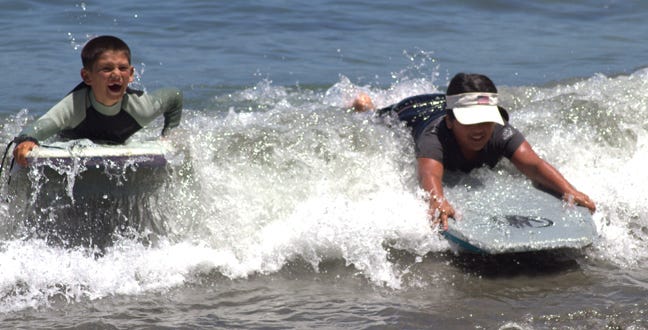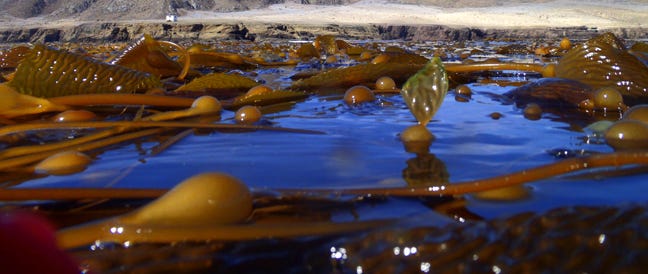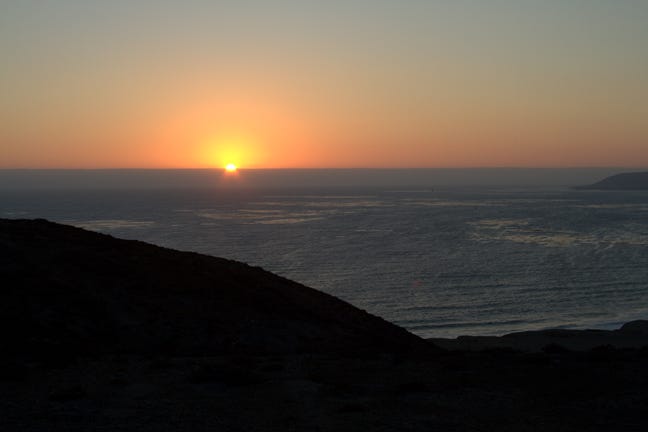For as long as I can recall, I have heard about the phenomenal Ama divers of Japan. I hadn’t realized until reading this story from the National Geographic blog that they were in decline. It makes sense, of course, as overfishing and climate change reduce their catch and younger generations show less and less interest in carrying on traditional livelihoods. Japan, notably, has a real problem with not enough people in the younger generations to care for the older generations.
The story reminded me of a group of working divers I met in Mexico. Their methods are totally different, but an entire community came together to dive for snails and sea cucumbers and support each other in the process. I met this group of harvesting divers when Dr. Matias Nochetto and I were working on the story about the lobster divers in Honduras. I didn’t end up getting to share much about them at the time because the Moskito divers were much more critical.
The diving “cooperativa” was located on Isla Natividad, a tiny speck of land in the Pacific Ocean, off the coast of Baja Sur in Mexico.
You can see mainland Baja California Sur from the eastern harbor area on Isla Natividad. It’s a little hazy but it’s over there. And off the northern end, past the lighthouse, you see Isla Cedros. Isla Natividad only has 400 or so inhabitants.
The view around the island is breathtaking, if the island itself is much less so. The tidal pools are fantastic and so are the rock reefs. You can see patches of giant kelp all around the island and the beaches on the western side are stunning.
The members of the cooperative understand the need to protect their environment above and below the water. They have a recycling program on the island where they bundle up paper, cardboard and plastic and take it to the station in Ensenada, but they admitted it wasn’t always been so clean.
There’s a library on the island, as well as a school for the elementary-aged kids.
Ultimately, that’s the point. They are very tight-knit, like a family. When one is hurt, they all pull together and do what they can to help. They work together and even when there is a dispute or a disagreement or contested election of the cooperative leaders, they say afterward they get together, have a party and are close friends again. Just like a family.
Part of the surrounding area is called the Vizcaino Marine Protected Area (MPA) where no harvesting or fishing is allowed. This area is intended to help the fisheries recover, giving fish, sea cucumber and lobster a place to reproduce and grow.
The connection to the ocean is what makes these divers continue doing what they are doing in spite of the risks they face. They take great pride in being fishermen and divers.
These divers, and the cooperative they belong to, recognize how important the ocean is to them and their way of life. They are more than willing to change if it means ultimately preserving their way of life.
The divers use a hookah system: a hose connecting a compressor on the boat to a regulator the diver wears. They don’t bother to wear fins. Instead, they wear double the weights a diver interested in swimming would wear and don work boots to literally run on the ocean bottom searching for their catch. Each dive they focus on one particular item. They collect sea cucumbers or snails or red algae, depending on the season.
To watch the diver do his job was very much like chasing a rabbit through a thicket. He moved so fast and so randomly. But it was very eye-opening to see how he worked. We were only diving in about 30 feet of water but normally, they dive much deeper and the work of breathing at those deeper depths is dramatically increased. I was breathing hard swimming around trying to keep up with him. I can only imagine what it would have been like at his normal depth.
This type of diving is dangerous. Since the divers use surface supplied air, there is no limiting factor on when they must surface. And the work of breathing raises the stakes even higher. They monitored their bottom time, but it wasn’t always enough. They had their own hyperbaric chamber on the island they used for dive emergencies. While we were there, a diver got in trouble and Mattias immediately stepped in to help guide his treatment. He was able to walk again when we left, but he had been fully paralyzed after his dive.
I find man’s interaction with the ocean fascinating. For me, diving and travel and exploration isn’t just about seeing things. Rather, it’s about understanding that interaction. People who make their living directly from the ocean, working on it or in it, see the ocean differently than those of us who simply visit it from time to time. The only way to understand that is to work directly with them.
Matias and I put on about three hours of presentations for the local divers, mostly just answering their questions. And that is where the connection in a place like this happens.
We stopped being tourists watching and started connecting with the divers as equals, helping them out and understanding what they do, how they live and what they think. You can’t understand people by standing on the outside. Travel is great, but getting to know people and become friends is the real purpose behind the adventure.
As a photographer, my first instinct is to grab my camera whenever something catches my attention. But, sometimes I just have to tell myself to sit and enjoy something. The last night on the island I watched an incredible sunset. The sun was already below the horizon, but the last strains of orange were still in the sky. It turned from violet to purple to black. There was a small home in the foreground lit up against the night. It was very striking, calming and moving all at the same time. And I left my camera in the bag. I guess I could have captured it to share, but I just wanted to enjoy it.
I’m keeping this Substack free for now, but if you’d like to support it anyway, buy me a cup of Kofi.
Check out my fiction at BooksbyEric.com.
I also recommend you follow me on my Facebook Author Page, Instagram and Threads.





